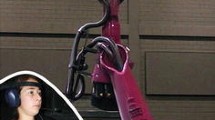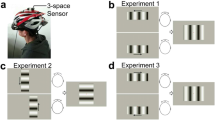Abstract
We examined the influence of dynamic visual scenes on the motion perception of subjects undergoing sinusoidal (0.45 Hz) roll swing motion at different radii. The visual scenes were presented on a flatscreen monitor with a monocular 40° field of view. There were three categories of trials: (1) trials in the dark; (2) trials where the visual scene matched the actual motion; and (3) trials where the visual scene showed swing motion at a different radius. Subjects verbally reported perceptions of head tilt and translation. When the visual and vestibular cues differed, subjects reported perceptions that were geometrically consistent with a radius between the radii of the visual scene and the actual motion. Even when sensations did not match either the visual or vestibular stimuli, reported motion perceptions were consistent with swing motions combining elements of each. Subjects were generally unable to detect cue conflicts or judge their own visual–vestibular biases, which suggests that the visual and vestibular self-motion cues are not independently accessible.







Similar content being viewed by others
References
Angelaki DE, McHenry MQ, Dickman DD, Newlands SD, Hess BJM (1999) Computation of inertial motion: neural strategies to resolve ambiguous otolith information. J Neurosci 19:316–327
Asch SE, Witkin HA (1948) Studies in space orientation. II. Perception of the upright with displaced visual fields and with body tilted. J Exp Psychol 38:455–477
Bagust J, Rix GD, Hurst HC (2005) Use of a Computer Rod and Frame (CRAF) Test to assess errors in the perception of a visual vertical in a clinical setting—a pilot study. Clin Chiro 8:134–139
Benson AJ (1978) Perceptual illusions. In: Dhenin G (ed) Aviation medicine. Tri-Med Books, London
Berger DR, Bulthoff HH (2009) The role of attention on the integration of visual and inertial cues. Exp Brain Res (in press)
Butler J, Smith ST, Beykirch K, Bulthoff HH (2006) Visual vestibular interactions for self motion estimation. In: DSC Europe, Paris
Cullen KE (2004) Sensory signals during active versus passive movement. Curr Opin Neurobiol 14:698–706
Cullen KE, Minor LB (2002) Semicircular canal afferents similarly encode active and passive head-on-body rotations: implications for the role of vestibular efference. J Neurosci 22:1–7
Dichgans J, Held R, Young LR, Brandt T (1972) Moving visual scenes influence the apparent direction of gravity. Science 178
Droulez J, Darlot C (1989) The geometric and dynamic implications of the coherence constraints in three-dimensional sensorimotor interactions. In: Jeannerod M (ed) Attention and performance. Lawrence Erlbaum, New Jersey, pp 495–562
Glasauer S (1995) Linear acceleration perception: frequency dependence of the hilltop illusion. Acta Otolaryngol Suppl 520:37–40
Grabherr L, Cuffel C, Guyot J-P, Mast FW (2008) Mental transformation abilities in unilateral and bilateral vestibular patients. In: FENS, Geneva, Switzerland
Gresty MA, Waters S, Bray A, Bunday K, Golding JF (2003) Impairment of spatial cognitive function with preservation of verbal performance during spatial disorientation. Curr Biol 13:R829–R830
Guedry FE, Harris CS (1963) Labyrinthine function related to experiments on the parallel swing. US Naval School of Aviation Medicine, Pensacola, FL
Haslwanter T, Jaeger R, Mayr S, Fetter M (2000) Three-dimensional eye-movement responses to off-vertical axis rotations in humans. Exp Brain Res 134:96–106
Henn V, Cohen B, Young LR (1980) Visual vestibular interaction in motion perception and the generation of nystagmus. Neurosci Res Program Bull 18:459–651
Howard IP (1982) Human visual orientation. Wiley, New York
Howard IP, Heckmann T (1989) Circular vection as a function of the relative sizes, distances, and positions of two competing visual displays. Perception 18:657–665
Israel I, Chapuis N, Glasauer S, Charade O, Berthoz A (1993) Estimation of passive horizontal linear whole-body displacement in humans. J Neurophys 70:1270–1273
Israel I, Sievering D, Koenig E (1995) Self-rotation estimate about the vertical axis. Acta Otolaryngol 115:3–8
Ivanenko Y, Grosso R, Isreal I, Berthoz A (1997) Spatial orientation in humans: perception of angular whole-body displacements in two-dimensional trajectories. Exp Brain Res 117:419–427
Jongkees LBW, Groen JJ (1946) The nature of vestibular stimulus. J Laryngol Otol 38:529–541
Lackner JR, DiZio P (2005) Vestibular, proprioceptive, and haptic contributions to spatial orientation. Annu Rev Psychol 56:115–147
Li W, Matin L (1995) Differences in influence between pitched-from-vertical and slanted-from-frontal horizontal lines on egocentric localization. Percept Psychophys 40:311–316
Lopez C, Lacour M, Magnan J, Borel L (2006) Visual field dependence–independence before and after unilateral vestibular loss. Audit Vestib Syst 17:797–803
Mayne R (1974) A systems concept of the vestibular organs. In: Kornhuber HH (ed) Handbook of sensory physiology. Vestibular system. Psychophysics, applied aspects and general interpretations. Springer, New York, pp 493–580
Merfeld DM, Zupan LH (2002) neural processing of gravitoinertial cues in humans. III. Modeling tilt and translation responses. J Neurophysiol 87:819–833
Merfeld DM, Young LR, Oman CM, Shelhamer MJ (1993) A multidimensional model of the effect of gravity on the spatial orientation of the monkey. J Vestib Res 3:141–161
Merfeld DM, Park S, Gianna-Poulin C, Black FO, Wood S (2005a) Vestibular perception and action employ qualitatively different mechanisms. I. Frequency response of VOR and perceptual responses during translation and tilt. J Neurophysiol 94:186–198
Merfeld DM, Park S, Gianna-Poulin C, Owen-Black F, Wood S (2005b) Vestibular perception and action employ qualitatively different mechanisms. II. VOR and perceptual responses during combined tilt & translation. J Neurophysiol 94
Mittelstaedt H (1999) The role of the otoliths in perception of the vertical and in path integration. Ann NY Acad Sci 871:334–344
Mittelstaedt ML, Mittelstaedt H (1996) The influence of otoliths and somatic graviceptors on angular velocity estimation. J Vestib Res 6:355–366
Mittelsteadt H (1997) Interaction of eye-, head-, and trunk-bound information in spatial perception and control. J Vestib Res 7:283–302
Paige GD, Telford L, Seidman SH, Barnes GR (1998) Human vestibuloocular reflex and its interactions with vision and fixation distance during linear and angular head movement. J Neurophysiol 80:2391–2404
Park S, Gianna-Poulin C, Owen-Black F, Wood S, Merfeld DM (2006) Roll rotation cues influence roll tilt perception assayed using a somatosensory technique. J Neurophysiol 96:486–491
Rader AA, Oman CM, Merfeld DM (2009) Motion perception during variable-radius swing motion in darkness. J Neurophys 102:2232–2244
Singer H, Purcell AT, Austin M (1970) The effects of structure and degree of tilt on the tilted room illusion. Percept Psychophys 7:250–252
Stevens SS (1957) On the psychophysical law. Psychol Rev 64:153–181
Vingerhoets RA, Medendorp WP, Van-Gisbergen JA (2006) Time course and magnitude of illusory translation perception during off-vertical axis rotation. J Neurophysiol 95:1571–1587
Vingerhoets RA, Vrijer MD, Gisbergen JAMV, Medendorp WP (2008) Fusion of visual and vestibular cues in the perception of visual vertical. J Neurophys
Wertheim AH, Mesland BS, Bles W (2001) Cognitive suppression of tilt sensations during linear horizontal self-motion in the dark. Perception 30
White H (1982) Instrumental variable regression with independent observations. Econometrics 50
Wright WG, DiZio P, Lackner JR (2005) Vertical linear self-motion perception during visual and inertial motion: more than a weighted summation of sensory inputs. J Vestib Res 15:185–195
Wright WG, Dizio P, Lackner JR (2006) Perceived self-motion in two visual contexts: dissociable mechanisms underlie perception. J Vestib Res 16:23–28
Wright WG, Schneider E, Glasauer S (2009) Compensatory manual motor responses while object wielding during combined linear visual and physical roll tilt stimulation. Exp Brain Res 192:683–694
Yasui S, Young LR (1975) Perceived visual motion as effective stimulus to pursuit eye movement system. Science 190
Young LR (1984) Perception of the body in space: mechanisms. In: Handbook of physiology the nervous system sensory processes. American Physiological Society, Bethesda, MD, pp 1023–1066
Zupan L, Merfeld DM (2003) Neural processing of gravito-inertial cues in humans. IV. Influence of visual rotational cues during roll optokinetic stimuli. J Neurophys 89:390–400
Acknowledgments
Funding for this experiment was generously provided by NASA (NNJ04HF79G) and NIH (NIDCD R01 DC04158). The authors would also like to thank the subjects who participated. This experiment protocol was approved by the MEEI and MIT IRBs.
Author information
Authors and Affiliations
Corresponding author
Rights and permissions
About this article
Cite this article
Rader, A.A., Oman, C.M. & Merfeld, D.M. Perceived tilt and translation during variable-radius swing motion with congruent or conflicting visual and vestibular cues. Exp Brain Res 210, 173–184 (2011). https://doi.org/10.1007/s00221-011-2612-4
Received:
Accepted:
Published:
Issue Date:
DOI: https://doi.org/10.1007/s00221-011-2612-4




